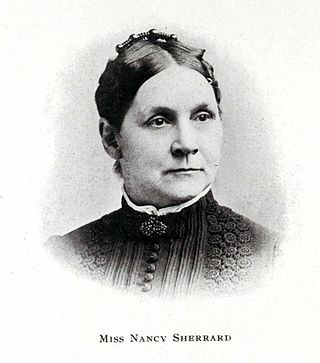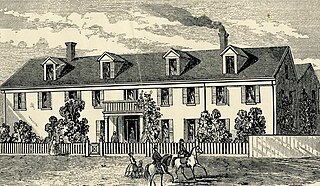
Clinton is a village in Oneida County, New York, United States. The population was 1,942 at the 2010 census, declining to 1,683 in the 2020 census, 13% decline). It was named for George Clinton, the first Governor of New York.

Steubenville is a city in and the county seat of Jefferson County, Ohio, United States. Located along the Ohio River 33 miles (53 km) west of Pittsburgh, it had a population of 18,161 at the 2020 census. The city's name is derived from Fort Steuben, a 1786 fort that sat within the city's current limits and was named for Prussian military officer Baron Friedrich Wilhelm von Steuben. It is a principal city of the Weirton–Steubenville metropolitan area, which had a 2020 population of 116,903 residents.

Princeton Theological Seminary (PTSem), officially The Theological Seminary of the Presbyterian Church, is a private school of theology in Princeton, New Jersey. Established in 1812, it is the second-oldest seminary in the United States, founded under the auspices of Archibald Alexander, the General Assembly of the Presbyterian Church (USA), and the College of New Jersey. It is also the largest of ten seminaries associated with the Presbyterian Church.

Piney Fork is an unincorporated community in central Smithfield Township, Jefferson County, Ohio, United States.1063420 The stream of Piney Fork flows southeast past the community; it meets Short Creek in far western Warren Township, and Short Creek in turn meets the Ohio River at Rayland.

Mount Hermon Female Seminary (1875—1924) in Clinton, Mississippi was a historically black institution of higher education for women.

Samuel Stokely was an American lawyer and politician who served one term as a U.S. Representative from Ohio from 1841 to 1843.
Poland Seminary, originally Poland Academy, was a name used for a series of schools operated in Poland, Ohio.

The Washington Female Seminary was a Presbyterian seminary for women operating from 1836 to 1948 in Washington, Pennsylvania. During the 19th century, it was "one of the best known and most noted institutions of its kind in the state".

Charles Clinton Beatty was a Presbyterian minister, seminary founder, and academic philanthropist.

Fort Steuben was a fortification erected in Feb. 1787 on the Ohio River in eastern Ohio Country at the northern end of the Seven Ranges land tract to be surveyed. It was at the location of the modern city of Steubenville, Ohio. The fort was built by Major John Hamtramck and named for Friedrich Wilhelm von Steuben, a Prussian army officer who had served under General Washington. The original purpose was to provide protection from Indians for the first surveyors to venture into the Northwest Territory.

The Oneida Institute was a short-lived (1827–1843) but highly influential school that was a national leader in the emerging abolitionist movement. It was the most radical school in the country, the first at which black men were just as welcome as whites. "Oneida was the seed of Lane Seminary, Western Reserve College, Oberlin and Knox colleges."
Boscobel College for Young Ladies was a college in Nashville, founded in 1889 as the Nashville Baptist Female College by the Tennessee Baptist Convention. The college operated for twenty-five years — until 1916. One of its founding objectives was to provide the lowest possible cost for higher-education of young women.

The Presbyterian Historical Society (PHS) is the oldest continuous denominational historical society in the United States. Its mission is to collect, preserve and share the history of the American Presbyterian and Reformed tradition with the church and broader community. It is a department of the Office of the General Assembly of the Presbyterian Church (U.S.A.).
James Weston Miller (1815-1888) was an American Presbyterian minister, educator and Confederate chaplain in Texas during the American Civil War. He helped establish the First Presbyterian church in Houston and many Baptist and Methodist churches and schools for blacks. He also taught many daughters of the Southern aristocracy at the Live Oak Female Seminary in Gay Hill, Texas.

Monroeville is an unincorporated community in Jefferson County, in the U.S. state of Ohio.
Amanda Reed McFarland (1832–1912) was an American missionary. She was the first woman missionary to the U.S. state of Alaska.

Samantha Knox Condit was an American teacher and Presbyterian missionary, working in the Chinese community of San Francisco, California and surroundings.

Marius Robinson (1806–1878) was an American minister, abolitionist, and newspaper editor of the antislavery newspaper The Philanthropist and The Anti-Slavery Bugle. He helped establish a school for African Americans in Cincinnati, Ohio while attending Lane Seminary. Responding to backlash from the city's residents, he continued to teach and was one of the Lane Rebels who would not be pressured to give up improving the lives of African Americans. He was an anti-slavery lecturer. He worked together with his wife Emily Rakestraw Robinson, to better the lives of African Americans.

Benicia Seminary was founded by a Board of Trustees in June 1852, as the Young Ladies' Seminary of Benicia in Solano County, California in the city of Benicia, California. The Benicia Seminary site is a California Historical Landmark No. 795 listed on September 6, 1964. At is peak the Young Ladies' Seminary of Beniciain had 149 students from all over Northern California. Young Ladies' Seminary of Beniciain was the Protestant Christian Junior college of its day. This was the first of this type of school in California. Mrs. S. A. Lord was the first School Principal in 1852, in 1853 Miss J. M. Hudson became Principal. In 1854, Atkins purchased the school. The Young Ladies' Seminary of Beniciain was sold to Cyrus Mills and Susan Mills in 1865 for $5,000, by Mary Atkins. Thus Benicia Seminary became Mills College. Mills College moved to Oakland, California in July 1871 by train, students, teacher and supplies. Mills College is still a private college. Mills College was granted a charter as a college by the State of california in 1885. Mary Atkins Lynch was born July 7, 1819, in Jefferson, Ohio. Mary Atkins married John Lynch (1824–1900) in 1869. Mary Lynch died September 14, 1882, at aged 63 in Benicia, California. Mary Lynch is buried at Benicia City Cemetery.
Marion Oliver was a female physician, who graduated in 1886 from the Women’s Medical College at Queen's University, in Kingston, Ontario, the first university women's medical school in Canada. She was the second female medical missionary sent by the Canadian Presbyterian Foreign Missionary Society, sailing to India on October 7, 1886. Oliver worked with and studied under both Emily Stowe and Jennie Trout the first licensed female physicians in Canada. Oliver co-founded a medical missionary hospital for women in Indore, India.















